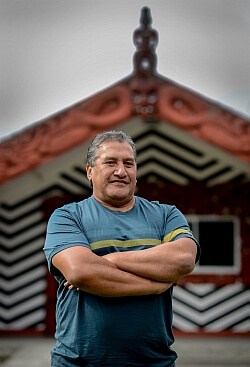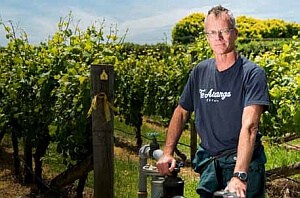Anyone who’s tasted water elsewhere understands how good our water is. So good there are plans afoot to bottle it up and export it offshore.
Drawn from the cool depths of an ancient underground reserve, this water’s what makes Hawke’s Bay a region of plenty – a fact we can appreciate each summer as the hills brown and the rivers drop while the shops and roadside stalls fill with fresh abundant produce.
Seven consents for water bottling purposes have been issued by the Hawke’s Bay Regional Council so far. If all exercised, they total nearly 2.5 million cubic metres of water a year. One company has applied to up their water-take volume from 364,000 m3 to 900,000 m3, and there are concerns increased water extraction will put undue pressure on the Heretaunga aquifer with long-term consequences for us all.
Already, in the 2013 drought, the rivers that replenish the aquifer were so depleted growers in the Twyford area faced a six-week irrigation ban.
Ngati Kahungunu has called for a moratorium on any exporting. In November they hosted a public hui at Waipatu Marae, which was attended by approximately 50 people, including two regional councillors. Ngahiwi Tomoana gave the history of Waipatu (which he translates as ‘artesian water’) – the marae moved originally from Pakowhai to Waipatu because of the artesian water, and the hapu see themselves as having a responsibility for it.
He talked about the Elwood Road bottling consent (at site of the former Tomoana freezing works), noting that the justification for using the bore there is “we used it before, we’ll use it again”. But the difference, he emphasised, is that the freezing works “used to be a big employer of the community, feeding a lot of whanau, but this will bring no return to our community.” Tomoana sees it as an “exporter’s dream”. They can skim off the resource “without spinning the local economic wheel”.
The bottom line for Tomoana: “We want to ensure that in 1,000 years’ time people can still live here and that the integrity of Papatuaanuku is kept intact.”
The consensus from this meeting was for a halt on all water bottling until more is known about the aquifer, and that Ngati Kahungunu take action on behalf of the wider Hawke’s Bay community to ensure transparent process.
Adele Whyte, Ngati Kahungunu’s CEO explains: “We’re not saying, categorically, don’t take the water. But we don’t think there’s enough information to make that decision, and if there is information available then we want to see it. We want to have the opportunity to sit down and be assured that it’s not going to impact existing growers and users of that water, because they’re already generating economic wealth for our region, and that it’s not going to impact the households and communities that have bore water. It’s a community resource; we all own it. If someone’s going to take it for their own profit, well let’s be really clear what the ramifications are.”
For the record, vice-president of Hawke’s Bay Winegrowers, Xan Harding, is “not a fan of bottled water.” It’s environmentally questionable, in his view.
While Harding “completely empathises” with the concerns expressed, he says it’s pretty hard to argue against on grounds of a competition for resources.
To put things in perspective, he tells me the catchment area for the Heretaunga Plains is about 6,000 ha with over 5 billion m3 water from rainfall alone flowing in each year. Annual consented water use is 300 million m3, which means only 6% of water coming into the catchment is allocated. The combined consents for water bottling represent a water volume less than 1% of what’s currently being used.
Harding’s a member of TANK (a forum for interest groups to promote consensus decision-making about water supplies around the Heretaunga Plains), and says “We have some confidence in the big picture, but more’s needed in the detail at the sub-catchment level – the linkages between ground water and surface water, for example. Before we give our recommendation to Council, we think Hawke’s Bay needs a better hydrological model for monitoring water.”
While he acknowledges there are localised seasonal effects that need managing, and agrees the precautionary principle should apply, he sees nothing to suggest significant concern for the aquifer itself. Harding does, however, question what Hawke’s Bay will really gain from exporting water, and believes we need to look at the way we allocate our resource, making judgements based on what’s good for the region socially, culturally and economically.
Hastings Mayor, Lawrence Yule, says he’s only aware of one consent for bottling water, and that’s at the old Tomoana Works. “We supported it at the Hastings District Council on the basis of 100 jobs being created. I don’t have the perspective on the volumes of water, but we were told by Regional Council there was lots of water, the existing bore was well-situated, and that 80% of the water goes out to sea anyway.”
Yule has always seen it as a “complementary use – if there’s surplus, why not extract it – but there’s no way I’d ever promote a whole-scale water-bottling scheme.” He sees that “Ultimately we need a policy around this. Under current New Zealand law, the policy of any natural resource really is ‘first in, first served’, and with water, priority is only really given to drinking, everything else is considered commercial. Clearly this needs to be revisited.”
Jerf van Beek, from HB Fruitgrowers’ Association and the Twyford Irrigation Group (TIG), suggests: “Let’s have a cup of tea, take a bit of a break, and get our heads round this. Once you provide a consent it’s very hard to withdraw it.”
While he’s confident there’s plenty of water, he doesn’t believe we understand the aquifer enough. “We don’t want to stifle economic development, but it needs to be sustainable, and it can only be sustainable if it’s measurable. That’s why we’ve partnered with HBRC to find out more.” The Fruitgrowers’ Association has sunk a 123 metre well (deep for Hawke’s Bay) expressly to research such things as connectivity between river flows and ground water levels: “We advocate the use of actual data gathering rather than desktop modelling.”
Asked how the water-bottling consents compare with growers’ takes, van Beek explains that water use is “over-allocated” to growers to ensure adequate supply but rarely made good on in reality. Last summer, Twyford growers used only 23% of their water allocation. “The difference is, we only use water if we require it – our use is either climatic or crop-stage driven, whereas a bottling plant’s use is entirely market driven. It’s not responsive to the environment or seasons and there are no restrictions at all within the allocated amount.”
There is a concerted effort by TIG to be more efficient and responsible with water. “We are working on putting a global consent together [for the Twyford area] to ensure safe, sustainable and competent water access,” says van Beek. “By stockpiling all our water we can budget amongst ourselves as to who can use water and when, based on need.” Surplus water can then be fed into rivers and streams, regulating temperature and volume and ensuring their health, along with increased efforts to plant up banks with riparian vegetation to cool waterways. Van Beek can’t see the water-bottle industry taking such a stewardship role.
“People need to understand how important horticulture is for our region – what it can do in terms of jobs, economic returns per hectare and carbon footprint. A bottling plant will simply take the water and ship it off with very little value-add, whereas we use it for growing produce to feed New Zealand and the world.” From a holistic point of view, he believes this is a far better use of our precious resource.




